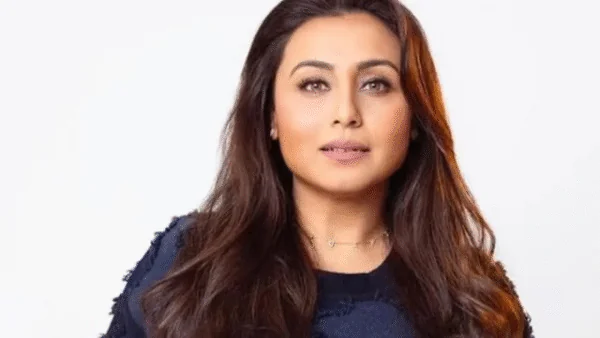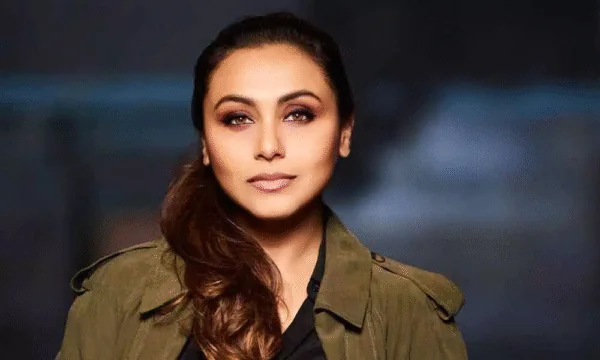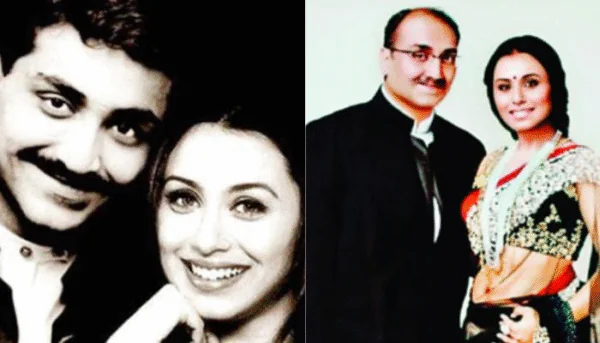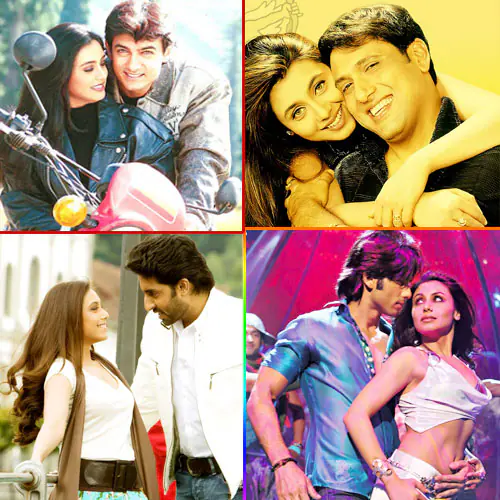Rani Mukherjee: Based on NeemTime research
Biography / Personal Details / Who is Rani Mukherjee
Rani Mukherjee is a celebrated Indian actress known for her powerful performances in Hindi cinema, particularly throughout the late 1990s and 2000s.
She was born on March 21, 1978, in Mumbai, Maharashtra, into a Bengali family deeply rooted in the Indian film industry.
Despite not initially wanting to act, she made her film debut with a Bengali film titled Biyer Phool in 1996, followed by her Bollywood debut in Raja Ki Aayegi Baraat the same year.
She gained widespread recognition after her supporting role in Kuch Kuch Hota Hai (1998), which became a major turning point in her career.
Known for her husky voice and expressive eyes, Rani carved a niche for herself by portraying emotionally complex characters.
She has received numerous accolades, including seven Filmfare Awards, making her one of Bollywood’s most awarded actresses.
Rani is known for her rare combination of commercial success and critical acclaim across diverse roles.
She has maintained a relatively private life, avoiding overexposure in the media compared to many of her peers.
In addition to acting, she is a social advocate and has supported causes related to women and children’s rights.
Rani is married to Aditya Chopra, one of Bollywood’s most influential producers, and is considered part of the film industry’s inner circle.
Background / Childhood / Early Life Highlights of Rani Mukherjee
Rani was born into the Mukherjee-Samarth film family, which includes notable figures such as her cousin Kajol and director Ayan Mukerji.
Her father, Ram Mukherjee, was a film director and one of the founders of Filmalaya Studios, while her mother, Krishna Mukherjee, was a playback singer.
She attended Maneckji Cooper High School in Juhu and later studied at Mithibai College in Mumbai, where she pursued Home Science and Odissi dance.
Despite her family’s cinematic background, Rani’s parents encouraged her to complete her education and did not initially push her into acting.
She trained in Odissi dance from a young age and has credited this training for helping her with her screen presence and posture.
Rani was never formally trained in acting but learned on the job, often crediting her early co-stars and directors for her development.
Her elder brother, Raja Mukherjee, was involved in filmmaking and once directed her in a lesser-known project.
Rani’s early exposure to film sets through her father helped her develop a comfort level with the camera before her formal debut.
Her initial interest was in fashion design or interior design rather than cinema.
She made her acting debut almost by chance, stepping in for a lead role when another actress dropped out of Raja Ki Aayegi Baraat.
Career / Other Work / Current Life Highlights of Rani Mukherjee
Rani’s early success with Kuch Kuch Hota Hai led to a string of box office hits including Saathiya, Hum Tum, and Veer-Zaara.
Her role in Black (2005), where she portrayed a deaf and blind woman, was critically acclaimed and earned her multiple Best Actress awards.
Rani often played strong, independent women in films, becoming a symbol of feminist representation in Bollywood during the 2000s.
She collaborated frequently with directors like Karan Johar, Yash Chopra, and Sanjay Leela Bhansali, becoming a favorite for both romantic and dramatic roles.
After a brief hiatus post-2010, she made a strong comeback with Mardaani (2014), playing a fierce female cop, which led to a sequel in 2019.
She starred in Hichki (2018), portraying a teacher with Tourette syndrome, which became a sleeper hit and was praised for its social message.
Rani is involved in her husband Aditya Chopra’s production house, Yash Raj Films, and often works selectively in high-impact roles.
She continues to advocate for child rights and women empowerment, associating with campaigns and NGOs in her personal capacity.
Her public appearances are rare and often limited to promotions, film festivals, or family-related events, keeping her profile low-key.
As of recent years, she has hinted at producing films and possibly stepping into mentorship or direction in the future.
Dating History / Family Members / Personal Life of Rani Mukherjee
Rani was romantically linked to several co-stars in the early 2000s, including Govinda and Abhishek Bachchan, though she rarely spoke publicly about her relationships.
Her eventual relationship with filmmaker Aditya Chopra remained largely private until they got married in a low-key ceremony in Italy in 2014.
Their wedding was attended by close family and friends, with almost no prior announcement or media coverage.
Rani and Aditya welcomed their daughter, Adira Chopra, in December 2015, and she has since focused significantly on motherhood.
She has mentioned in interviews that motherhood changed her life and made her more selective about work.
Rani maintains close ties with her cousin Kajol, and the two are often seen together during family events or private functions.
Despite being married to one of Bollywood’s most powerful producers, Rani rarely uses her personal life for publicity or leverage.
Her daughter Adira is kept away from the spotlight, with Rani emphasizing the importance of a normal childhood.
Rani’s family also includes her brother Raja Mukherjee, who has worked as a producer and director in Indian cinema.
She has credited her family, especially her late father, for instilling discipline, humility, and respect for the craft of acting.
Rani Mukherjee Family

Rani Mukherjee Family 5

Rani Mukherjee Family 4

Rani Mukherjee Family 3

Rani Mukherjee Family 2

Rani Mukherjee Family
Height / How to Get Body Like Rani Mukherjee
Rani Mukherjee stands at approximately 5 feet 3 inches tall, making her one of Bollywood’s petite yet powerfully present actresses.
Her fitness routine is focused on maintaining lean muscle tone through yoga, Pilates, and functional training rather than weight lifting.
Rani’s body transformation for films like Mardaani involved high-intensity workouts and martial arts-based agility drills.
She has followed a diet high in protein and fiber, avoiding processed foods and sugar to maintain her stamina and metabolism.
Her daily wellness regimen includes drinking warm water with lemon in the morning and keeping herself hydrated throughout the day.
Rani trains with professional celebrity fitness experts who design short but effective workouts tailored to her film roles.
She prefers home-cooked meals with a focus on Indian cuisine, portion control, and balanced macros to stay fit without overexertion.
Her glowing skin and youthful energy are often credited to disciplined sleep patterns and minimalistic skincare routines.
Rani also practices meditation and breathing exercises to manage stress and keep her mental health in check.
For those wanting a physique like Rani’s, consistency in functional workouts, a mindful diet, and emotional balance are key elements.
Interview Quotes of Rani Mukherjee (where/when)
In a 2014 India Today Conclave interview, Rani said, “A woman doesn’t need a man to define her existence,” emphasizing her feminist views.
During Koffee with Karan Season 2, Rani humorously stated, “I’d rather be known for my work than my waistline,” showcasing her focus on talent over appearance.
In a Filmfare interview in 2018, she noted, “My daughter is my biggest strength and my biggest weakness,” reflecting on motherhood.
At the 2019 Women in Film event, she said, “Cinema must show women as fighters, not just as victims,” aligning with her role in Mardaani.
In an old Rediff chat session in the early 2000s, Rani shared, “I don’t come from dreams, I come from struggle,” referencing her early career battles.
During a 2005 IIFA press conference, she remarked, “I have no godfathers, only work that speaks for itself,” addressing nepotism.
In a 2020 interview with Hindustan Times, she said, “I want my daughter to see me as someone who never gave up,” tying into her values as a parent.
Speaking to Rajeev Masand in 2015, Rani revealed, “Acting is not about fame; it’s about feeling deeply and connecting with strangers.”
During a Mardaani 2 promotional event, she firmly stated, “Empowered women need to be loud and clear,” addressing societal double standards.
On being asked about her selective projects, she said in a 2021 interview, “I only return when the story is worth telling,” signaling her current creative priorities.
TV / Movie Quotes of Rani Mukherjee (where/when)
In Kuch Kuch Hota Hai (1998), she famously said, “Kuch kuch hota hai, Rahul. Tum nahi samjhoge,” a line that became a pop culture staple.
Her powerful dialogue from Black (2005) was, “Main kuch bhi kar sakti hoon,” showcasing the resilience of her character.
In Hum Tum (2004), she said, “Pyaar dosti hai,” a line echoing modern love and friendship dynamics.
From Mardaani (2014), her gritty line, “Yeh shikaar karne wali kaun hai? Shivani Shivaji Roy naam hai mera,” established her as a fierce cop.
In Veer-Zaara (2004), she emotionally said, “Veer ke liye toh main sab kuch kar sakti hoon,” underlining loyalty and sacrifice.
Her role in Hichki (2018) featured the quote, “Har kamzori ek taqat ban sakti hai,” promoting self-acceptance and perseverance.
From Saathiya (2002), she softly said, “Kya tum mujhse pyaar karte ho ya sirf aadat hai?” reflecting relationship dilemmas.
In Kabhi Alvida Naa Kehna (2006), her line, “Galtiyaan karne ka haq sirf insaan ko hota hai,” emphasized human flaws and forgiveness.
On Koffee with Karan, she playfully said, “I may be short, but I have big dreams,” when asked about her screen presence.
In Bunty Aur Babli (2005), her quirky tone delivered, “Babli naam hai mera, aur thag le jaungi,” giving a mischievous flair to her character.
Controversies / Gossip / Scandals of Rani Mukherjee
Rani Mukherjee faced early criticism for her voice, with many suggesting she dub her lines, which she refused to do, later turning it into her trademark.
Her rumored relationship with Govinda in the late 1990s stirred headlines, especially as he was already married at the time.
She maintained silence during media speculation around her relationship with Aditya Chopra, refusing to confirm it for years until their marriage.
Rani reportedly had a fallout with Karan Johar around the time of Kabhi Alvida Naa Kehna, which was later resolved, though both remained discreet.
In 2010, her appearance at an event sparked debate over a dramatic skin tone change, prompting accusations of promoting fairness standards.
She was once criticized for defending her friend Salman Khan during his legal controversies, calling media criticism unfair.
Rani’s limited interactions with media over the years led to gossip about her being aloof or difficult, which she denied in interviews.
Some film critics accused her of being typecast in tragic or emotionally heavy roles, especially during the 2004–2007 period.
She faced backlash for not speaking openly about her marriage or showing her daughter in public, which many saw as overly secretive.
Despite being surrounded by industry family, Rani has often been a target in the nepotism debate, though she insists her career was built without favors.
Lesser Known Unknown Facts Trivia of Rani Mukherjee
Rani Mukherjee trained in Odissi dance during her school years and once considered becoming a professional dancer before choosing acting.
Despite being from a film family, she made her debut in a Bengali film Biyer Phool before entering Bollywood with Raja Ki Aayegi Baraat.
She was originally offered the role of Tina in Kuch Kuch Hota Hai only after several leading actresses turned it down.
Rani has a degree in Home Science and studied at Mithibai College in Mumbai, staying grounded in academics during her early years.
Her husky voice, once seen as a flaw in the film industry, became one of her most distinctive and celebrated traits.
She turned down several major international offers, including a role in The Namesake, prioritizing Hindi cinema over crossover fame.
Rani is extremely private and rarely attends Bollywood parties, which has kept her personal life shielded from tabloid exposure.
She does not have any official social media accounts, making her one of the few major celebrities who stay entirely offline.
Rani was once ranked among the highest-paid actresses in India during the mid-2000s, a rare feat for someone without active PR strategies.
Her character in Hichki was based on a real-life woman living with Tourette syndrome, and Rani spent time studying the condition to prepare for the role.
Most Commonly Frequently Discussed Questions/Topics with Answers on Rani Mukherjee
Why did Rani Mukherjee disappear from films for a few years?
Many fans believe she took a conscious break to focus on her marriage and motherhood, returning only for roles that deeply resonated with her.
Is Rani Mukherjee underrated compared to other Bollywood actresses of her era?
Yes, fans discussions often credit her with powerful performances but say she didn’t receive as many awards due to lack of aggressive self-promotion.
What makes Rani Mukherjee’s acting style unique?
Fans appreciate her natural dialogue delivery, expressive eyes, and emotional range, especially in films like Black and Mardaani.
Why is she not active on social media like other celebrities?
Fans often speculate that her media-shy personality and preference for privacy keep her off platforms like Instagram and Twitter.
Is Rani Mukherjee related to Kajol?
Yes, users clarify that they are cousins from the Mukherjee-Samarth film family, though they rarely appear publicly together.
What’s her most impactful role to date?
The majority vote goes to her performance in Black, with threads often praising her intense transformation and emotional commitment.
How is Rani Mukherjee viewed among younger Bollywood fans?
Fans threads show younger audiences admire her legacy but feel she’s not marketed well to Gen Z viewers due to her low profile.
Was there real tension between Rani Mukherjee and Aishwarya Rai?
There’s speculation based on casting overlaps, particularly in Chalte Chalte, but nothing confirmed—most users see it as media-driven rivalry.
How did she prepare for her role in Mardaani?
Fans note she underwent police training and consulted female officers to accurately portray the role of a tough cop.
What’s the reason for her selective film choices post-2010?
Many fans believe she’s focused on quality over quantity, only choosing roles that offer depth and reflect her growth as a performer and person.